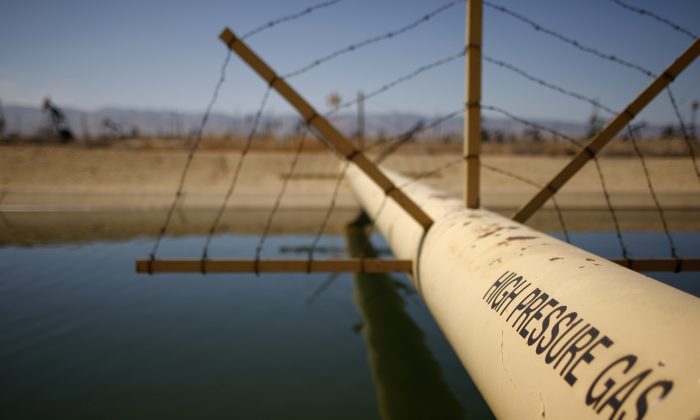US Should Recognize American Samoans as Citizens, Judge Says
Fracking insiders said that the dynamic growth of shale in recent years is suffering a slowdown as industry investors demand higher returns and lower debt.
Shale producers such as Pioneer, Range Resources, EQT Corp, and Whiting Petroleum have reduced production targets and cut staff, aiming to meet investors’ bottom-line demands for more profit and less leverage.
“This was a hard decision to make and one we did not take lightly, but ultimately it was a necessary, prudent action,” Range Resources CEO Jeff Ventura told Reuters of his firm’s actions.
The company has sold $1.1 billion in assets, closed offices, and reduced staff, using proceeds to buy back shares and reduce debt amid weaker oil prices.
“Fracking is a uniquely American success story that has provided immense benefits around the nation,” the Independent Petroleum Association of America said. “By safely unlocking America’s abundant natural resources, fracking has created millions of American jobs, reduced energy prices, brought cleaner air by significantly reducing U.S. greenhouse gas emissions to 25-year-lows, strengthened our national security, and transformed the United States into a global energy superpower.”
 This Aug. 22, 2019, photo shows a Chevron oil exploration drilling site near Midland, Texas, U.S. Reuters/Jessica Lutz/File Photo)
This Aug. 22, 2019, photo shows a Chevron oil exploration drilling site near Midland, Texas, U.S. Reuters/Jessica Lutz/File Photo)Shale output in the United States has surged to nearly 13 million barrels per day (bpd), making the nation the world’s largest crude oil producer and a major exporter.
Recently, the United States hit a milestone in the Trump administration’s quest for energy independence, becoming a net exporter of crude and petroleum products for a full month for the first time in 70 years, according to government data. U.S. monthly oil exports surpassed imports by 89,000 barrels per day in September, making the country a net exporter on a monthly basis for the first time since the government started tracking relevant data in 1949, according to figures published by the Energy Information Administration (EIA).
But the shale outlook for 2020 comes with growing skepticism from those inside the industry.
“I don’t think OPEC has to worry that much more about U.S. shale growth long term,” Pioneer Natural Resources Chief Executive Scott Sheffield said last month, noting oil majors are the last companies aggressively drilling in the Permian Basin, the top U.S. shale field.
Producers have reduced the number of oil rigs operating for a record 12th month in a row, sidelining a quarter of the country’s drilling rigs in the past year, according to service firm Baker Hughes.
A representative of oil-field equipment company RK Supply, which operates in the Midland area, told The Wall Street Journal that as shale producers cut back on new projects, the company has put its hiring plans on hold.
“It affects everybody’s bottom lines,” said Homer Daniels, of RK Supply.
 Pump jacks operate in front of a drilling rig in an oil field in Midland, Texas U.S., on Aug. 22, 2018. (Reuters/Nick Oxford/File Photo)
Pump jacks operate in front of a drilling rig in an oil field in Midland, Texas U.S., on Aug. 22, 2018. (Reuters/Nick Oxford/File Photo)‘A Little Bit Oversupplied’
U.S. oil production next year will rise by 1 million bpd, U.S. Energy Information Administration predicted, with most of the gains attributed to shale.
Global inventories are “a little bit oversupplied,” said Ian Nieboer, an analyst with researcher RS Energy Group, which puts U.S. growth at about 100,000 bpd next year. “It puts a lid on any optimism.”
Oil majors Exxon Mobil Corp and Chevron Corp have not pulled back from their Permian plans. Exxon is targeting 1 million bpd of production by 2024 in the Permian and Chevron is aiming for 900,000 bpd a year earlier. Top Permian producer Pioneer also recently increased its forecast for this year’s oil output and aims for a mid-teens percentage gain over several years.
Oil majors are less susceptible to lower prices and will continue to invest in the Permian, said Muqsit Ashraf, senior managing director for energy at Accenture Strategy, adding that the largest independents also are likely to expand output.
Increased scale will give the majors an edge in the Permian, said Chris Snyder, an oil analyst at Deutsche Bank.
“Historically shale was a cottage industry, with one well drilled at a time and each done differently,” said Snyder. “As we move to this manufacturing approach, that favors the skill sets of majors.”
“They’re excellent project managers,” he added.
 Oil pump jacks work at sunset near Midland, Texas, U.S., on Aug. 21, 2019. (Reuters/Jessica Lutz/File Photo)
Oil pump jacks work at sunset near Midland, Texas, U.S., on Aug. 21, 2019. (Reuters/Jessica Lutz/File Photo)‘What Is Fracking?’
Fracking is a way to extract resources from deep underground, including oil, natural gas, geothermal energy, or water.
In the United States, over 1.7 million wells have been completed using the fracking drilling technology.
“Put simply, hydraulic fracturing is the process of injecting liquid and materials at high pressure to create small fractures within tight shale formations to stimulate the production and safely extract energy from an underground well after the drilling has ended and the rig and derrick are removed from the site,” IPAA explains.
“The process takes about three to five days, on average, to complete from start to finish. Once the fracturing operation is finished, the well is considered “completed” and is now ready to safely produce American oil or natural gas for years, even decades, to come.”
The IPAA estimates that the fracking process has led to the production of over seven billion barrels of oil and 600 trillion cubic feet of natural gas.
Reuters contributed to this report.
This article is from the Internet:Profit and Debt Pressures Spark Slowdown in Shale
Congressman Suggests National Guard Could Enforce Gun Laws in Virginia
